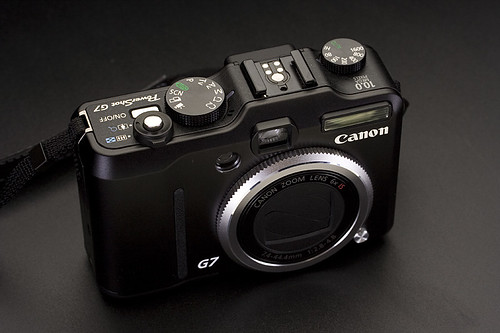Difference between revisions of "Canon PowerShot G7"
(stub with pool photo) |
m |
||
| Line 13: | Line 13: | ||
In this era, the appearance of USD ~$500 [[DSLR]]s (including [[Canon EOS 400D|Canon's own]]) seemed to killing the market for higher-spec fixed lens cameras. And in certain ways the G7 was a step backwards from its predecessor, the [[Canon PowerShot G6]]. The sensor of the G7 did increase its megapixel count, from 7 to 10; the zoom range went from 4x to 6x, and a trimmer, black-finished metal body lent a "quality" appearance. But the [[Lens#Lens_Speed|lens speed]] lost a full f-stop; and the rear LCD no longer had a tilt/swivel hinge. Also missing was the ability to record images in RAW mode, and the top-panel status LCD. | In this era, the appearance of USD ~$500 [[DSLR]]s (including [[Canon EOS 400D|Canon's own]]) seemed to killing the market for higher-spec fixed lens cameras. And in certain ways the G7 was a step backwards from its predecessor, the [[Canon PowerShot G6]]. The sensor of the G7 did increase its megapixel count, from 7 to 10; the zoom range went from 4x to 6x, and a trimmer, black-finished metal body lent a "quality" appearance. But the [[Lens#Lens_Speed|lens speed]] lost a full f-stop; and the rear LCD no longer had a tilt/swivel hinge. Also missing was the ability to record images in RAW mode, and the top-panel status LCD. | ||
| − | Ultimately, Canon did not even produce an expected "G8" successor to the G7, instead skipping directly to the [[Canon PowerShot G9|G9]] in 2007. And it perhaps was only with the [[Canon PowerShot G11|G11]] that Canon returned to the true spirit of the G series: a full-featured, RAW-capable enthusiast model for those seeking a small one-piece alternative to a full DSLR kit. | + | Ultimately, Canon did not even produce an expected "G8" successor to the G7, instead skipping directly to the [[Canon PowerShot G9|PowerShot G9]] in 2007. And it perhaps was only with the [[Canon PowerShot G11|G11]] that Canon returned to the true spirit of the G series: a full-featured, RAW-capable enthusiast model for those seeking a small one-piece alternative to a full DSLR kit. |
==Links== | ==Links== | ||
*[http://www.dpreview.com/reviews/canong7/ PowerShot G7 reviewed] at [http://www.dpreview.com/ DPReview.com] | *[http://www.dpreview.com/reviews/canong7/ PowerShot G7 reviewed] at [http://www.dpreview.com/ DPReview.com] | ||
Revision as of 13:26, 7 July 2011

|
| With lens retracted image by Fabio Rombauer (Image rights) |
Canon introduced the PowerShot G7 in 2006, as an evolution of the G series of compacts aimed at enthusiast photographers.
In this era, the appearance of USD ~$500 DSLRs (including Canon's own) seemed to killing the market for higher-spec fixed lens cameras. And in certain ways the G7 was a step backwards from its predecessor, the Canon PowerShot G6. The sensor of the G7 did increase its megapixel count, from 7 to 10; the zoom range went from 4x to 6x, and a trimmer, black-finished metal body lent a "quality" appearance. But the lens speed lost a full f-stop; and the rear LCD no longer had a tilt/swivel hinge. Also missing was the ability to record images in RAW mode, and the top-panel status LCD.
Ultimately, Canon did not even produce an expected "G8" successor to the G7, instead skipping directly to the PowerShot G9 in 2007. And it perhaps was only with the G11 that Canon returned to the true spirit of the G series: a full-featured, RAW-capable enthusiast model for those seeking a small one-piece alternative to a full DSLR kit.